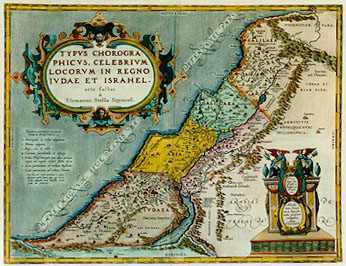Cartographica Neerlandica Background for Ortelius Map No. 180

TYPVS CHOROGRA:|PHICVS, CELEBRIVM | LOCORVM IN REGNO | IVDAE ET ISRAHEL. | arte factus | à | Tilemanno Stella Sigenensi. [A chorographical map of the famous places in the kingdom of Judea and Israel, made with skill by Tileman Stella of Siegen.] (Cartouche bottom right:) "Priui:|legio Im:|periali, et | Belgico, ad | decenni:|um. | Abraha:|mus Orteli:|us in hanc for:|mam minorem|redigebat. | Anno" | m.d.lxxxvi. [With an imperial and Belgian privilege for ten years edited in this modest form, in the year 1586 by Abraham Ortelius.] (Lower left:) EXPLICATIONES CHARAC:|TERVM POSITIONIS/ [symbol] "Metropoles et vrbes insigniores". | [symbol] "Minus insignes". | [symbol] "Pagi, vici et villæ". | [symbol] "Ciuitates sacerdotales et refugij". | [symbol] "Vrbes Philistinorum, quæ alias quinque | regiæ, vel reguli vocari solent. Ios.13". | [symbol] "Loca pertinentia ad tribum Ephraim". | [symbol] "Loca pertinentia ad tribum Simeon. | Hæc loca per notas peculiares à ceteris | discernere coacti sumus, quia per vicinas | tribus dispersa, certis limitibus circum:|scribi non potuerunt". [Explications of the position of symbols. [symbol] Significant metropoles and cities; [symbol] Less significant places; [symbol] Villages, areas and mansions; [symbol] Holy places and places of refuge; [symbol] Cities of the Philistines, which comprise five kingdoms, commonly called petty kingdoms, Ioshua 13; [symbol] Places belonging to the tribe of Ephraim; [symbol] Places belonging to the tribe of Simeon; These places are distinguished from the rest by specific symbols. We were forced to do this because, since the tribes have been dispersed over various areas, we cannot provide certain borders between them].
Plate size: 356 x 461 mm.
Scale: 1 : 950,000.
Identification number: Ort 180 (Koeman/Meurer: 22P, Karrow: 1/182, vdKrogtAN: 8155H:31).
Occurrence in Theatrum editions and page number:
1590L4Addblank, (100 copies printed) (identical in text and typesetting to 1592L but here without page number; last line, in very small Greek script: mochthèron limnaion, hota gen Samena ktènè tsichas kai hoplas kai kerata apoballes.)
1591G4Addblank, (75 copies printed) (last line first text page, right aligned, in Gothic script like the entire text: ten; last line second text page, left aligned, in Gothic script like the entire text: weit von dannen bei der Statt Gadara gelegen/ davon Strabo vermeldet/&c.),
1592L19 (525 copies printed) (text and typesetting identical to 1590L4Add, but here with page number 19; last line, left aligned, very small Greek script: mochthèron limnaion, hota gen Samena ktènè tsichas kai hoplas kai kerata apoballes); typesetting except for page number identical to the typesetting of 1590L4Add),
1595La (500 copies printed) (last line, left aligned, very small Greek script: mochthèron limnaion, hota gen Samena ktènè tsichas kai hoplas kai kerata apoballes); typesetting except for page number identical to the typesetting of 1590L4Add),
1601Liij (200 copies printed) (last line, left aligned, very small Greek script: mochthèron limnaion, hota gen Samena ktènè tsichas kai hoplas kai kerata apoballes),
1602G4 (250 copies printed) (last line first text page, right aligned, in Gothic script like the entire text: Geneza ; last line second text page, left aligned: zareth/davonoben meldung geschehen/verstanden werde/sonder ein anderer weit von dannen bey der Statt Gadara gelegen/dauon Strabo vermeldete.),
1603Liij (300 copies printed) (last line, left aligned: distans Gadara, de quo in quit Strabo [in very small Greek script:] esi de kai on tè gadaridi udoor mochthèron limnaion, hota gen Samena ktènè trichas kai hoplas kai kerata apoballes.),
1606Eiij (300 copies printed) (last line, full width, first text page, italic like most of this text: "of the damned: and indeed the etymologie also doth somewhat fauour this sense, for" Hinnon "is a spoiler ,destroier, conspiratour or traitour", Ios.15.18 Mat. 18./GENEZARETH, ; last line second text page, left aligned: The water also of the lake of "Gadira" is troubled and muddy, of which if any beast do drinke, they will cast their haire, their hoofes and their hornes.),
1608/1612Iiij (300 copies printed) (last line, first text page, right aligned: HAY ; last line second text page, left aligned: quale benuta dal bestiame,fa loro cader i peli,& l'vngie,& le corna.),
1609/1612Siij (300 copies printed) (text in Latin, see 1609/1612L),
1609/1612Liij (300 copies printed) (last line, left aligned: procul inde distans Gadara, de quo inquit Strabo [in very small Greek script:] esi de kai on tè gadaridi udoor mochthèron limnaion, hota gen Samena ktènè trichas kai hoplas kai kerata apoballes.),
1624ParergonL/1641Siij (1025 copies printed) (last line second column first text page: Ægypto erant circumcisi, iam anteà in deserto obierant, Ios.iv.v./Eamdem ; last line second column second text page, in cursive script: "nua amittunt").
Approximate number of copies printed: 4175.
States: 180.1 as described.
180:2: "Chades | barnea" just above Sin desertum bottom left changed to "Cades Barne" in 1624.
Cartographic sources: this map was made by Ortelius on the basis of Stella's 1552 and 1557 maps of the Holy Land, (Meurer p. 244-245, Karrow 72/1, p. 500-503) and on information from the bible.
References: R.V. Tooley (1978) Maps of Palestine in the Atlas of Ortelius, "The Map Collector" 3: 28-31.
For questions/comments concerning this page, please e-mail info@orteliusmaps.com.